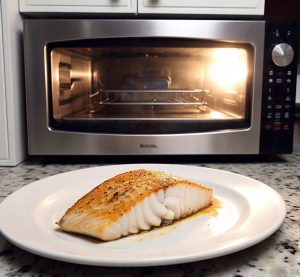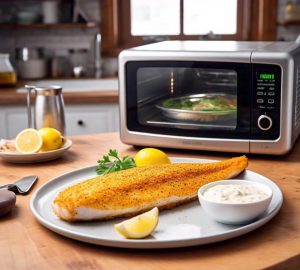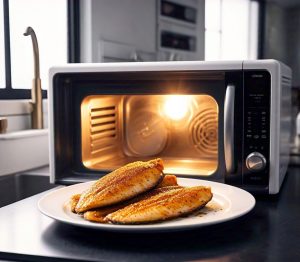We’re making fish in the microwave that’s flavorful and never rubbery, and we’re skipping the salmon this time.
Get ready for three easy recipes using basa, catfish, and other white fish that cook in minutes.
This article shows you how to make amazing microwave fish with big flavor and perfect texture every time.
Jump To:
Flavorful Bengali Mustard Fish in the Microwave
Bengali mustard fish transforms white fish into something spectacular with bold mustard oil and aromatic spices. We’re making this traditional recipe using the microwave for quick weeknight dinners.
The mustard paste creates an incredible flavor coating that penetrates the fish while cooking. From our experience, this works best with firm white fish like cod, haddock, or tilapia.
Start by marinating your fish fillets in turmeric and salt for 15 minutes. Mix mustard seeds, green chilies, and a pinch of sugar into a paste with mustard oil.
What we found works best is coating the fish generously with this paste before microwaving. Cook on 70% power for 3-4 minutes, checking halfway through to prevent overcooking.
Simple Lemon Herb Microwave Basa Fillet
Basa fillets are perfect for microwave cooking because they’re mild, flaky, and cook evenly. This lemon herb version gives you restaurant-quality fish in under 5 minutes.
We love using fresh herbs like dill, parsley, and thyme mixed with lemon juice and olive oil. The key is creating a herb butter that melts over the fish as it cooks.
Place your basa fillet in a microwave-safe dish and dot with herb butter. Add thin lemon slices on top and cover with microwave-safe plastic wrap.
From our testing, basa cooks perfectly in 2-3 minutes on high power. The fish should flake easily with a fork when done, and the herbs will be fragrant and bright.
Southern-style Microwave Blackened Catfish
Southern blackened catfish gets its signature flavor from cajun spices and high heat. We’re adapting this classic for the microwave using a spice blend that creates amazing flavor without the smoke.
Mix paprika, cayenne, garlic powder, oregano, and thyme for your blackening spice. The secret is using enough spice to create a thick coating on the catfish fillet.
What I found works best is patting the catfish dry before applying the spice rub. Press the spices into the fish to help them stick during cooking.
Microwave on high for 3-4 minutes, depending on thickness. The spices will form a flavorful crust while keeping the fish moist inside. One mistake we made early on was overcooking – catfish can go from perfect to tough quickly.
Also See: Microwave Vanilla Sprinkle Cake: Quick & Delicious!
Preventing Rubbery Texture in Microwave Fish
Rubbery fish is the biggest microwave cooking mistake we see, but it’s completely preventable with the right technique. The secret lies in controlling power levels and timing.
From our experience, high power is the enemy of tender fish. We always cook fish at 70% power or lower to prevent the proteins from seizing up and becoming tough.
What I found works best is using the pierce-and-check method. Pierce the thickest part of the fillet with a fork every minute to test doneness. The fish should flake easily without resistance.
Moisture is your friend when microwaving fish. We add a tablespoon of white wine, lemon juice, or even water to the dish before cooking. This creates steam that keeps the fish moist.
Cover your fish with microwave-safe plastic wrap or a vented microwave cover. This traps steam while allowing excess moisture to escape, preventing that dreaded rubbery texture.
One mistake I made early on was cooking fish straight from the fridge. Let your fillets sit at room temperature for 10-15 minutes before microwaving for more even cooking.
Thin fillets cook faster than thick ones, so adjust your timing accordingly. A 1-inch thick fillet needs about 4-5 minutes at 70% power, while thinner pieces only need 2-3 minutes.
How to Cook Frozen Fish Fillets in the Microwave
Cooking frozen fish fillets requires a two-stage approach that first thaws, then cooks the fish evenly. We skip the traditional thawing time by doing both steps in the microwave.
Start by placing your frozen fillet in a microwave-safe dish with a tablespoon of water. Microwave on 30% power for 2-3 minutes to begin the thawing process.
What we found works best is flipping the fillet halfway through this initial thawing stage. This prevents hot spots and ensures even defrosting throughout the fish.
After the initial thaw, increase power to 70% and cook for an additional 3-4 minutes. The fish should be opaque and flake easily when done.
From our testing, thicker frozen fillets benefit from a brief rest period. Let the fish sit for 1-2 minutes after the first cooking cycle to allow heat to distribute evenly.
One thing I learned the hard way is that frozen fish releases more moisture during cooking. Place paper towels under your dish to catch excess liquid and prevent soggy results.
Never try to rush frozen fish by using full power. This creates tough, unevenly cooked fish with rubbery edges and cold centers. Low and slow wins every time.
We’ve shared three simple and delicious ways to enjoy fish without ever turning on your oven.
Each recipe brings unique flavors and textures, from the spicy kick of blackened catfish to the zesty lemon herb basa.
Remember to keep an eye on cooking times and use a cover to lock in moisture for the best results.
Grab your favorite fillet and give one of these recipes a try tonight—your taste buds will thank you!






